ISMAILI WOMEN come from a proud and rich heritage of intellectual prowess, spiritual illumination, and strength against adversity. Ismaili Gnosis @ Instagram presents a series on the history of strong Ismaili women starting with Hazrat Khadijah, the wife of Prophet Muhammad. On Instagram this can be viewed at (https://instagram.com/explore/tags/ismailiwomen/).
In Ismaili history, women have not only played important material and political roles. The Ismaili esoteric tradition recognizes a number of women who held important spiritual ranks and performed religious functions alongside the Prophets and Imams: Hazrat Eve with Prophet Adam, Hazrat Hagar with Prophet Abraham, Hazrat Zulaykhah with Prophet Joseph, Hazrat Maryam with Prophet Moses, Hazrat Maryam with Prophet Jesus, Hazrat Khadijah and Hazrat Fatimah with Prophet Muhammad, and numerous other women with the Imams.
According to the Ismaili esoteric interpretation of prophetic history, these women were the hujjats (proofs) of the Imam: they held the rank of spiritual mother [like the Ismaili Pirs] and were responsible for disseminating the esoteric knowledge or ta’wil of the Imams to the disciples. In this sense Qadi al-Nu’man (Asas al-Ta’wil, 58-59) explains the inner meaning of the Qur’anic verse 4:1 which says God created Adam’s wife from him with the words: “your Lord who created you from a Single Soul and created its mate from it” (rabbakum alladhi khalaqakum min nafsin wahidatan wa khalaqa minha zawjaha) or the biblical idea that God created Eve from Adam’s rib: God did not perform some surgical procedure on Adam. The real meaning is that Eve’s soul was nourished and illuminated with knowledge from Adam’s soul through ta’yid (spiritual inspiration); Eve is one of the hujjats of Adam as every Imam has 12 hujjats of the day and 12 hujjats of the night who disseminate his esoteric teachings in the same way that human beings have 12 ribs on the left side and 12 ribs on the right side. Above these 24 hujjats, the Imam is surrounded by 4 special hujjats who are his spiritual wives and one of these special hujjats was usually a woman. The Qur’an 33:6 – “The Prophet has more authority over the believers than their own souls and his wives are their mothers” refers to the hujjats or spiritual wives of the Prophet and not his physical wives. So Eve being from Adam’s ribs means she was Adam’s hujjat and became his spiritual wife; she is the bearer of the ta’wil of Adam’s prophetic revelation:
On the earthly plane, we find Eve, as Adam’s wife, typifying the esoteric content of the shari‘ah; she is the one who knows its meanings contained within the symbols, and that is why Adam cannot fulfill the shari‘ah of this cycle without her. This Adam-Eve mystery reappears in all the periods: just as the Ka’bah is the symbol of the Hujjat, so is Noah’s ark (safinah); only those who take their place there will find salvation. It is only through the Hujjat) that one may be conjoined with the Imam. The “Supreme Mary” (Maryam al-Kubra), who in turn exemplifies the heavenly Eve, was Jesus’ Hujjat because it was she who opened the doors of gnosis which had been closed, by being the first to appeal to ‘Isa [Jesus], the master of the new shari‘ah. Similarly, the “Supreme Fatima” (Fatima al-Kubra) was the Hujjat of the first Imam during the period of the “sixth Adam.”
– Henry Corbin, (Cyclical Times and Ismaili Gnosis, 183)
Typically, this female hujjat was a daughter of an Imam, a wife of an Imam, or a mother of an Imam. Bibi Fatimah al-Zahra possessed all three of these relationships. Each of these great women are the manifestation of the “Esoteric Feminine” – the Celestial Light which the Ismaili metaphysics calls the Universal Soul (al-nafs al-kull) and the biblical tradition calls Sophia. In the process of creation, God originates the Universal Intellect (al-‘aql al-kull) – the first of all spiritual beings in creation. The Universal Soul emanates from the Universal Intellect, and this Universal Soul creates and sustains the Cosmos.

In the World of Religion, the hujjat is the locus of manifestation (mazhar) of the Universal Soul while the Imam is the locus of manifestation (mazhar) of the Universal Intellect. The Celestial Feminine or Universal Soul is most often associated with Bibi Fatimah al-Zahra, the daughter of the Prophet, but it is manifested by all of the female hujjats:
Fatimah the Radiant (Fatimah al-Zahra) appears as an archetype exemplified in numerous recurrences, which are carefully noted by the typology of Ismaili ta’wil. Generally speaking, the feminine figures who exemplify this archetype are, like Fatimah herself above all, so many typifications of gnosis (‘ilm al-batin, ‘ilm al-haqiqah), of the initiation into this gnosis, and of the Life which this gnosis breathes into the “dead,” i.e., into those who are unknowing and unconscious. Thus, her esoteric rank is above all that of the Hujjat, the “Proof” or Witness of the Imam, indeed even a substitute for the Imam who, being in possession of the ta’wil, is the source of that Life which resurrects the dead.
– Henry Corbin, (Cyclical Times and Ismaili Gnosis, 182)
Among these female hujjats of the Imam were women responsible for the spiritual preparation and training of the future Prophet: Maryam was the hujjat of the Imam Khuzaymah on whose behalf she initiated and trained Jesus – the meaning of Jesus being born without a father refers to his spiritual birth, his spiritual initiation into the Religion of Truth occurring through his spiritual mother Maryam (the hujjat) without the direct intervention of the Imam (spiritual father); Hazrat Khadijah was the hujjat of Imam Abu Talib with whom she spiritually initiated the Prophet Muhammad (this is described in the Fatimid text Sara’ir wa Asrar al-Nutuqa by Ja’far ibn Mansur al-Yaman and discussed here). “A special study ought to be devoted to this conception which invests feminine figures with the eminent dignity of the Hujjat who “initiates” the future Prophet” (Corbin, 97). After Prophet Muhammad, his daughter Hazrat Fatimah was the hujjat of Imam ‘Ali; Hazrat Zaynab was the hujjat of Imam al-Husayn and Imam Zayn al-Abidin. Hazrat Sitt al-Mulk was the hujjat of Imam al-Hakim and Imam al-Zahir. Each of the three women with the title of Mata Salamat – Hazrat Pir Maryam Sarkar, Hazrat Shams al-Mulk (Lady ‘Ali Shah), and Hazrat Begum Yvette Omm Habibeh Aga Khan – was the hujjat of the respective Imam of her time. All of these hujjats played important roles in the history of Imamat which includes being the spiritual/physical companion of the Imam, assisting him in his mission, disseminating the Imam’s esoteric knowledge, and safeguarding the succession of the future Imam:
The Hujjat connects to the Glorious Entity, which is the Imam, and the Hujjat is the Great Mary (maryam al-kubra) – her peace be upon us – who casts forth all things and shapes them, and lays their foundation and creates them…This is the “new creation” in the esoteric meaning, and she is the Great Fatimah (fatimah al-kubra) in the time of the sixth Adam, who is Muhammad. She is the great fa’ and the veil established for the people who are intimate with knowledge and seek intimacy with his Spirit.
– Sayyidna Ja’far ibn Mansur al-Yemen, (Kitab al-Kashf, tr. Seth Abd al-Hakeem Carney)
There is also one secretive but crucial role that a number of women — both ‘Alid and non-‘Alid — are said to have played in the early Shi‘ite community: They were often reported in Shi‘ite hadith traditions to be the bearers of the wasaya, or the formal testimonies and transmissions of authority from one Imam to the next… Some of the women who transferred these testaments of successorship were ‘Alid women related to the Imams. For example, Zaynab bint ‘Ali is said to have carried her brother, al-Husayn’s, wasiyyah to her nephew, ‘Ali Zayn al-‘Abidin.
– Maria Massi Dakake, (The Charismatic Community, 220-21)
The below posts from Ismaili Gnosis @ Instagram highlight some of the important women in Ismaili history as documented in scholarly sources. Many of these women were the female hujjats described above and others were women who played unique and important roles. In all cases, Ismaili women come from a history of intellectual prowess and spiritual strength which all Ismaili Muslims can be proud of.
1. Hazrat Khadijah al-Kubra
Hazrat Khadijah was not just a successful business woman who married a younger man; she also had an important religious function in the Religion of Truth and occupied a high spiritual rank. Details on this available here.
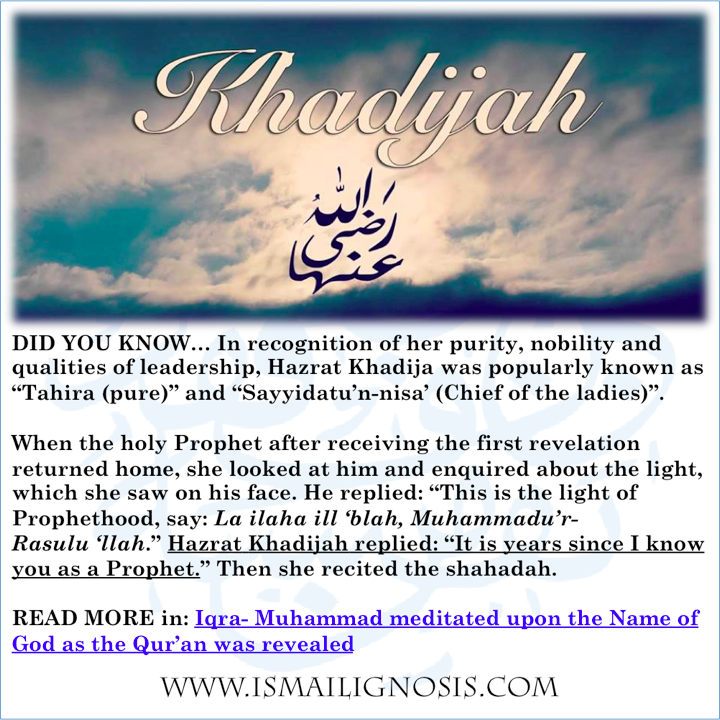
2. Hazrat Fatimah al-Zahra
Fatimah al-Zahra was the only surviving daughter of the Prophet Muhammad, the wife of Imam ‘Ali ibn Abi Talib, and the mother of the Imam al-Hasan and Imam al-Husayn through whom the Prophet’s lineage continues. She is among the Ahl al-Bayt whom the Qur’an declares to be pure of all impurities in 33:33. Early Fatimid scholars argued that Fatimah held a position of precedence in relation to the Prophet’s wives, because, unlike them, her link to the Prophet was direct, through blood. The Fatimid Caliphate founded by the Ismaili Imams was named after her and Fatimah’s name and titles are found in Fatimid coins and talismans and were mentioned in the khutba upon the Fatimid conquest of Egypt. The Fatimids celebrated her birthday and made it into a holiday, when gifts were exchanged among the palace people.
3. Hazrat Zaynab bint Ali
Zaynab bint Ali was the daughter of Imam ‘Ali ibn Abi Talib and Fatimah al-Zahra and succeeded to the spiritual rank of her grandmother Khadijah al-Kubra and her mother Fatimah al-Zahra. Zaynab is best known for her piety, knowledge, and her saving the life of her nephew, Imam ‘Ali Zayn al-Abidin, at the battle of Karbala. She played the role of the guarantor who safeguarded and ensured the continuity of the Imamat in the lineage of Imam al-Husayn.
3. Hazrat Sakinah bint al-Husayn
Sayyida Sakinah was the most beloved daughter of Imam al-Husayn ibn ‘Ali and used to sleep on his chest every night. Imam al-Husayn was often heard saying, “A house without Sayyida Sakinah would not be worth living in.” As a child, when Sayyida Sakinah went to bed at night she wanted to spend some time with her father. Imam al-Husayn would tell her stories of the Prophet Muhammad and of the battles fought by her grandfather ‘Ali ibn Abi Talib. Sayyidna Sakinah was a powerful personality: she never wore a veil and demanded monogamy from her husbands – she married and divorced about 5-6 men. Sakinah was described by al-Zubairi, a historian who, like many others, was full of admiration for her, in these words: “She radiates like an ardent fire. Sakinah was a delicate beauty, never veiled, who attended the Quraysh Nobility Council. Poets gathered in her house. She was refined and playful.” (see Fatima Mernissi, Women’s Rebellion and Islamic Memory, 83, 114-115).
4. Sayyida Sitt al-Mulk
There were a number of powerful and pious royal women in the Fatimid period who hailed from the family of the Imams. The Imam al-Mu’izz had two daughters – Sayyida al-Rashida and Sayyida ‘Abda. They each lived well into their nineties and never married but accumulated large sums of wealth and property which they left for the Fatimid Caliph. Imam al-Hakim had a famous daughter known as Sitt al-Misr (Lady of Egypt). All of these women were known for their virtue and simple lifestyles. The most famous of the Fatimid royal women was Sitt al-Mulk, the favourite daughter of Imam al-‘Aziz and the half-sister of the Imam al-Hakim.
5. Sayyida al-Rasad
When the Imam al-Mustansir bi’llah became the Imam and Fatimid Caliph at the age of 7, his Sudanese mother Sayyida al-Rasad served as his regent and administered the affairs of the state.
6. Hazrat Pir Maryam Khatun Mata Salamat I
Maryam Khatun was the first cousin and wife of Imam Khalil Allah (45th Imam). She was the mother of Imam Hasan ‘Ali Shah (Aga Khan I). Upon the death of Imam Khalil Allah, it was Maryam Khatun who intervened with the Qajar rulers to ensure that Imam Hasan ‘Ali Shah, who was then only a teenager, received all of his rights, that the Imam’s family was provided for, and that the murders were administered justice. In this respect, Maryam Khatun played a similar role as Bibi Fatimah al-Zahra and Sitt al-Mulk in guaranteeing the succession of the young Imam. She was given the title Mata Salamat by Imam Hasan ‘Ali Shah in 1245/1829 and, in the same year, he sent her to India as the Pir (when she was 85 years old) to deal with internal community disputes. She died three years later in Kutchh but was interred in Najaf.
8. Shams al-Mulk Lady ‘Ali Shah Mata Salamat II
Shams al-Mulk was a Qajar princess and after her marriage to Imam Aga ‘Ali Shah, she became known as Lady ‘Ali Shah. She gave birth to Imam Sultan Muhammad Shah Aga Khan III and cared for him amidst unique circumstances:
Soon after the death of Pir Shihabuddin Shah in 1884, Imam Aga Ali Shah conferred upon her the title of Mata Salamat in Bomba. Imam Sultan Muhammad Shah Aga Khan deeply loved his mother and she inspired some of his progressive policies toward the emancipation of women. When Imam Sultan Muhammad Shah became Imam at the age of 7, Lady ‘Ali Shah served as his regent – administering the communal affairs of the Ismailis and wisely managing the family’s financial resources. She testified in favour of the Imam in the Haji Bibi Case of 1908 and the judge commended her for her stellar memory.
She expired on February 5, 1938 at the age of 90 years and was buried at Najaf next to the tomb of her husband. Speaking of his mother, Imam Sultan Muhammad Shah once wrote: “She had been to me more than father and mother combined, since I lost my father at the age of 8. No loss, even that of my son who died in infancy which was a terrible blow to me as a father, has been quite so terrible as this.” About the greatness of his mother and their close relationship, Imam Sultan Muhammad Shah once wrote:
The story of Lady ‘Ali Shah’s last moments are quite moving: Realizing that her end was near, she told to Kamadia Khan Bahadur: “Send my love to all the members of the Ismaili community. I may not return to India, but wherever my spirit be I will eternally watch their peaceful progress and prosperity, as I have done all my life.” Imam Sultan Muhammad Shah had made every arrangement for his mother’s comfort at Baghdad, and for that reason, he took with him Kamadia Khan Bahadur’s son, Hussain Ali, by air to Basra, where, under the Imam’s instructions, he made all possible arrangements for a quiet landing. A saloon car was ready to convey Lady ‘Ali Shah from Basra to Baghdad, where a bungalow, belonging to her nephew, Aga Hamid Khan, was placed at her disposal. She arrived at Baghdad on February 4, 1938 at 1 pm. The Imam’s travels to the West had increased, causing his longer stay away from India. His mother had felt the pangs of this separation, and once she said to her son: “Death is inevitable, but if it comes to me in your absence, it will be unendurable.” The Imam’s reply brought her great solace, who said: “Do not worry. You will breathe your last with your head in my lap.” Consequently, Imam Sultan Muhammad Shah and his wife reached Baghdad by air from Cairo on February 5, 1938 at 3 pm., and Lady ‘Ali Shah passed away at 5.15 pm on the same day, breathing her last in the lap of her son, as the Imam himself narrates in his Memoirs:
A few minutes after I reached her bedside, her eyes opened, and she recognized me. Then in the way that all true Muslims would ask, who seek to follow the Prophet’s example and attain a safe and quiet journey from the midst of the living, she achieved peace and happiness and that final ‘Companionship on High’ for which all yearn.
– Imam Sultan Muhammad Shah Aga Khan III,
(Memoirs of the Aga Khan: World Enough and Time)
8. Begum Yvette Omm Habibeh Mata Salamat III
Begum Yvette Aga Khan was the fourth wife of Imam Sultan Muhammad Shah. She had already converted to Islam before she met the Imam and had been living in Egypt prior to their marriage in 1944. The Imam bestowed on her the titles Omm Habibeh (beloved mother) and Mata Salamat in 1954 during the Platinum Jubilee celebrations. It is reported that the Imam had been reminded of his own mother, Lady ‘Ali Shah, on this occasion and was moved to tears when he gave the same title to his last wife. Even more revealing are the statements that Imam Sultan Muhammad Shah made about his wife Mata Salamat in his Memoirs – declaring that his wife truly recognized his own mind and spirit and that their marriage was one of physical, mental, and spiritual union. Such language is a clear indication that this Mata Salamat was at the rank of hujjat and spiritual wife of the Imam like the other female hujjats of the past.
When Imam Sultan Muhammad Shah passed away and was succeeded by his grandson Mawlana Shah Karim al-Husayni Aga Khan IV, Begum Mata Salamat served as a witness and guarantor of the Imamat succession – in the same way that prior female hujjats had done so in the past in the cases of Hazrat Fatimah al-Zahra, Hazrat Zaynab, Sitt al-Mulk, Maryam Khatun, and Lady ‘Ali Shah:
Begum Mata Salamat remained in love with Imam Sultan Muhammad Shah even after his death. It is reported that she would bring a red rose to his tomb every day and have the Qur’an recited in his mausoleum every morning. Speaking about her spiritual connection to the late Imam, even after his death, the Begum said:
9. Princess Zahra Aga Khan
Princess Zahra Aga Khan is the eldest child of Mawlana Hazar Imam. She has been an incredible support to the Imam of the Time, traveling with him constantly and working toward the betterment of the Ismaili community. She is particularly supportive of Ismaili women and youth. Below is an excerpt of a speech she gave at International Ismaili Women’s Forum in 1997:
This list of extraordinary Ismaili Women is by no means exhaustive and will continually be updated by the Ismaili Gnosis Instagram team. Follow Ismaili Gnosis @ Instagram and keep looking for more profiles of the incredible women from Ismaili history at: https://instagram.com/explore/tags/ismailiwomen/
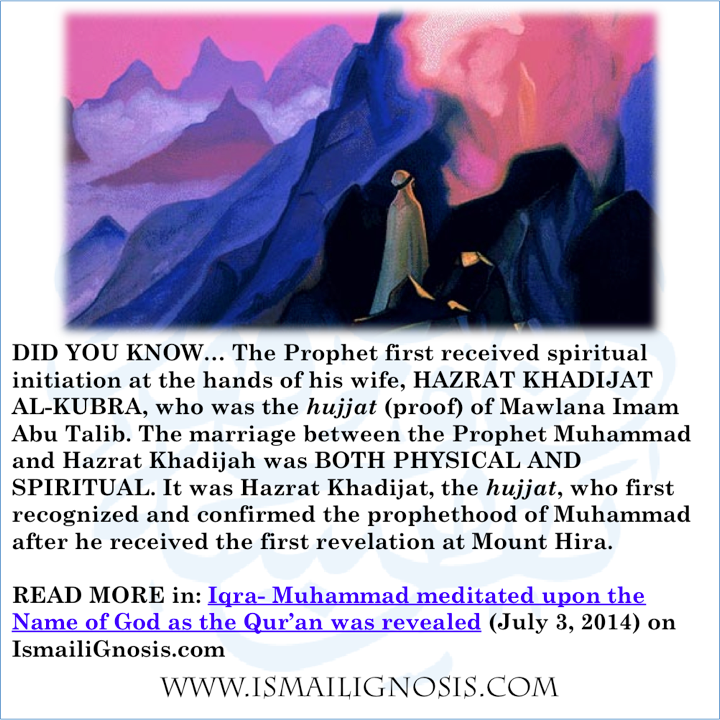
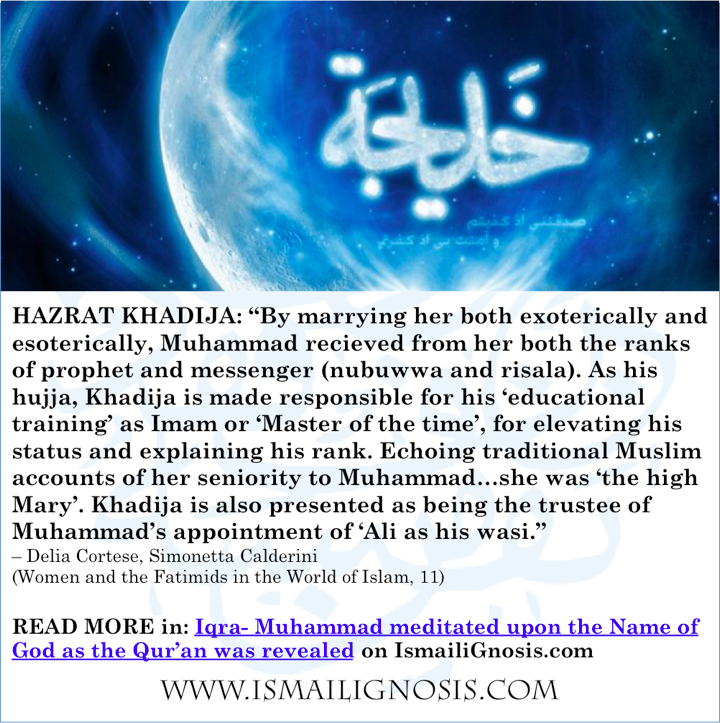
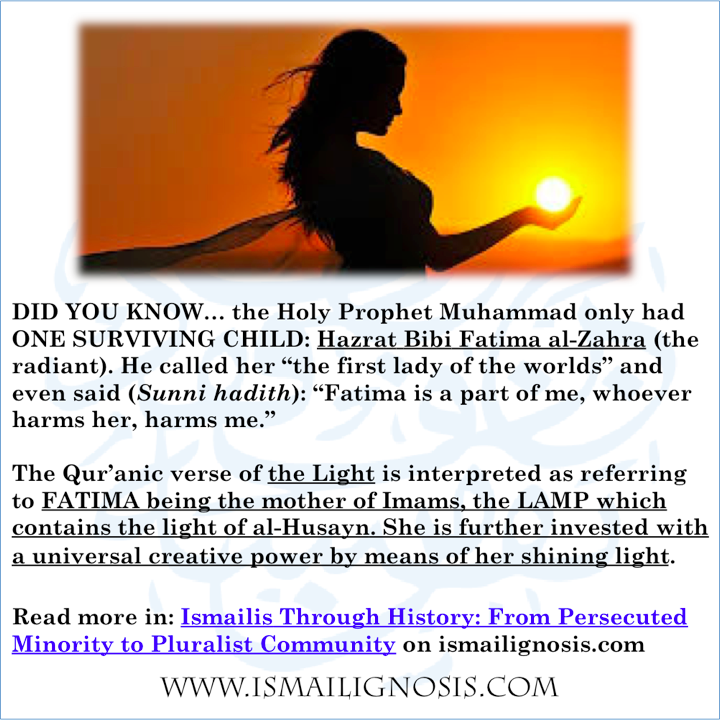
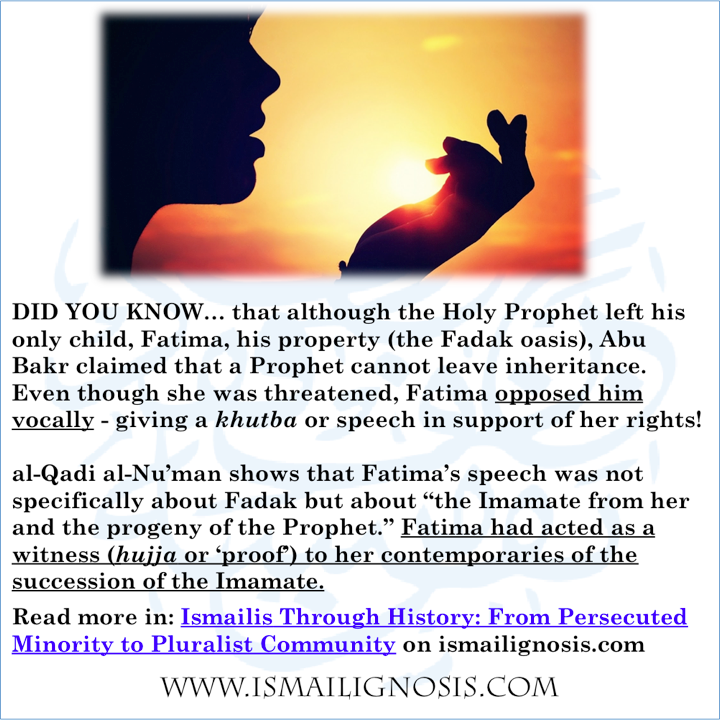

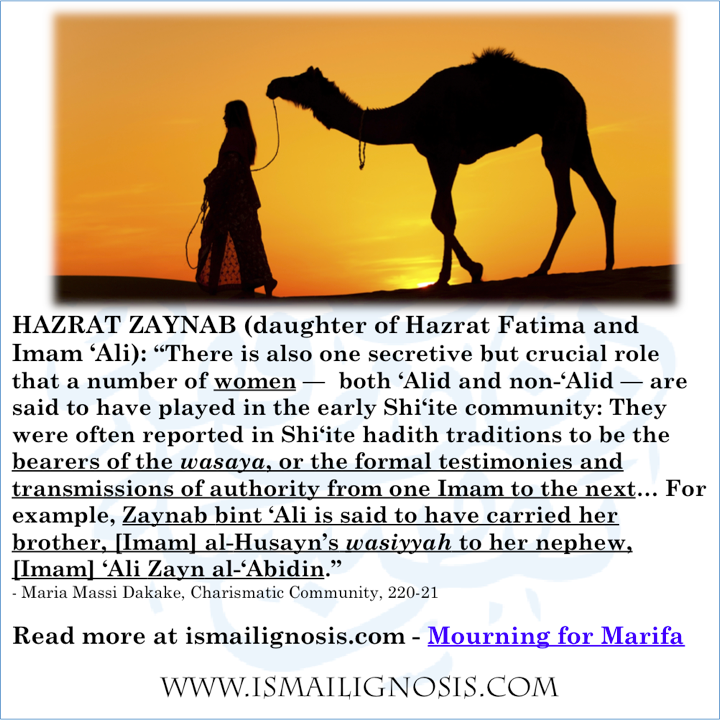
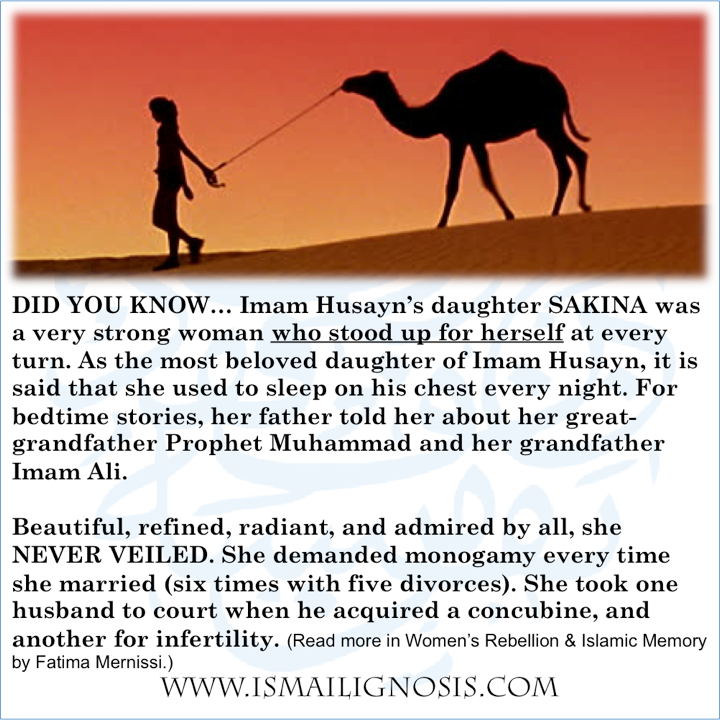
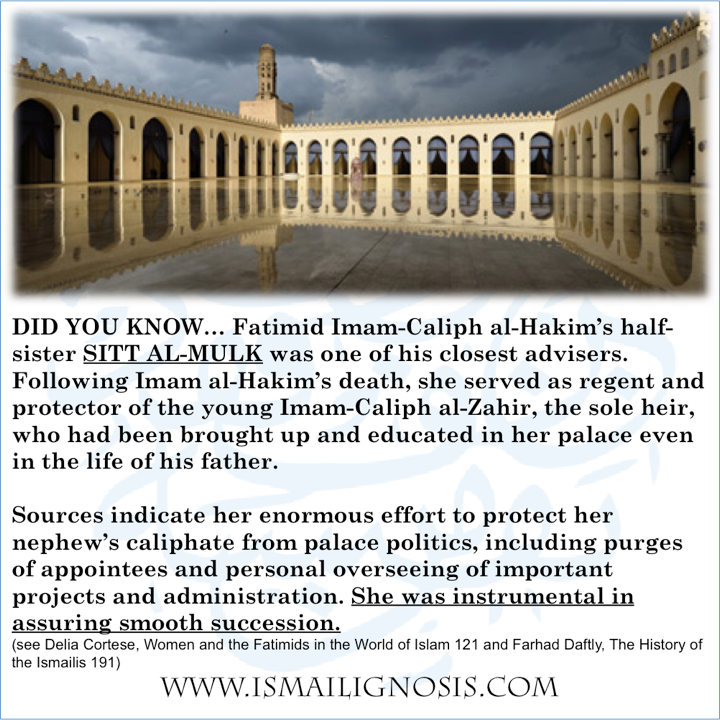
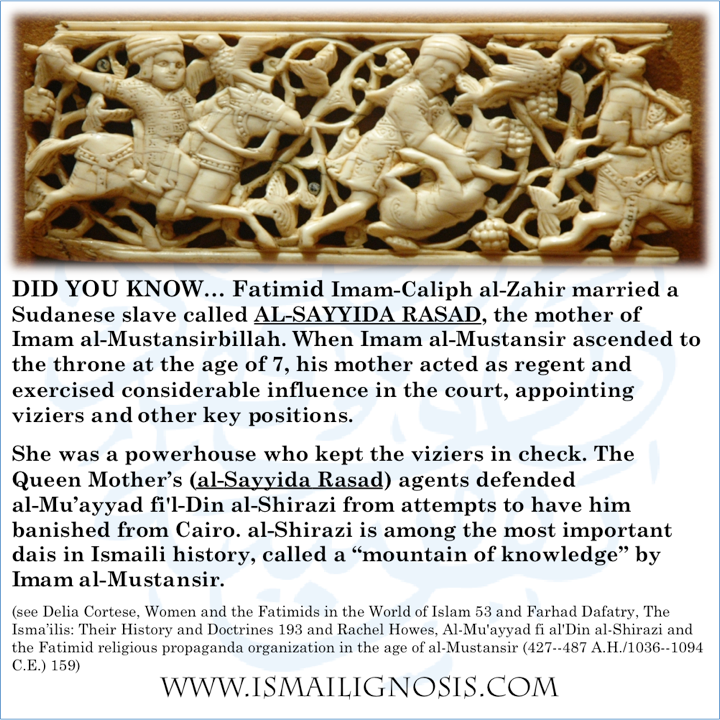
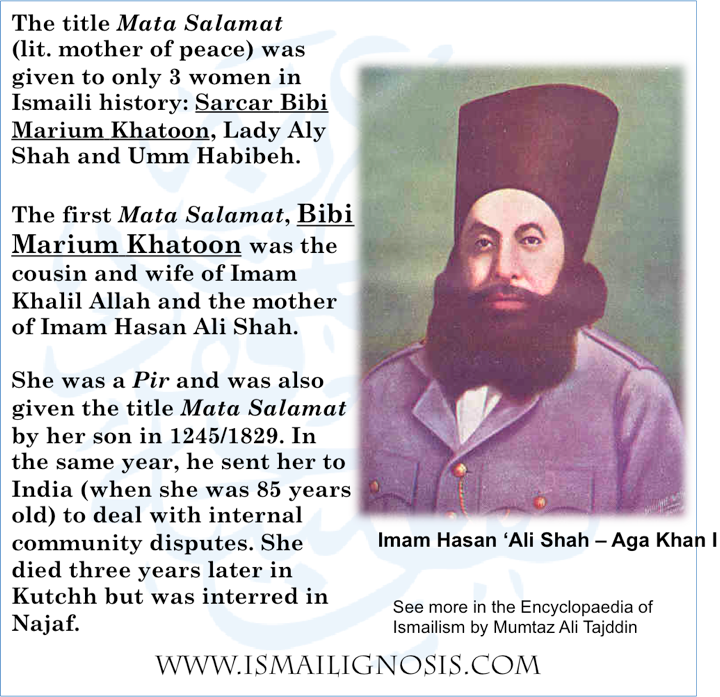
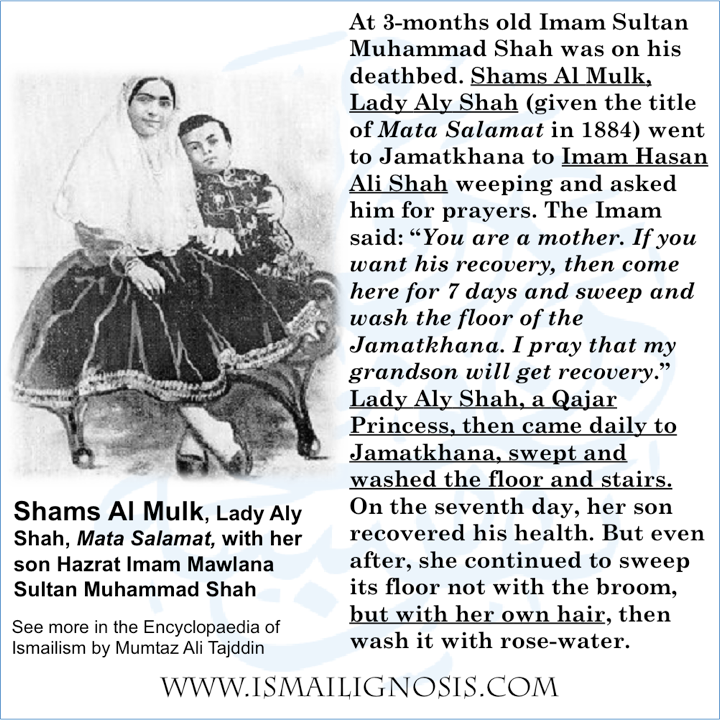
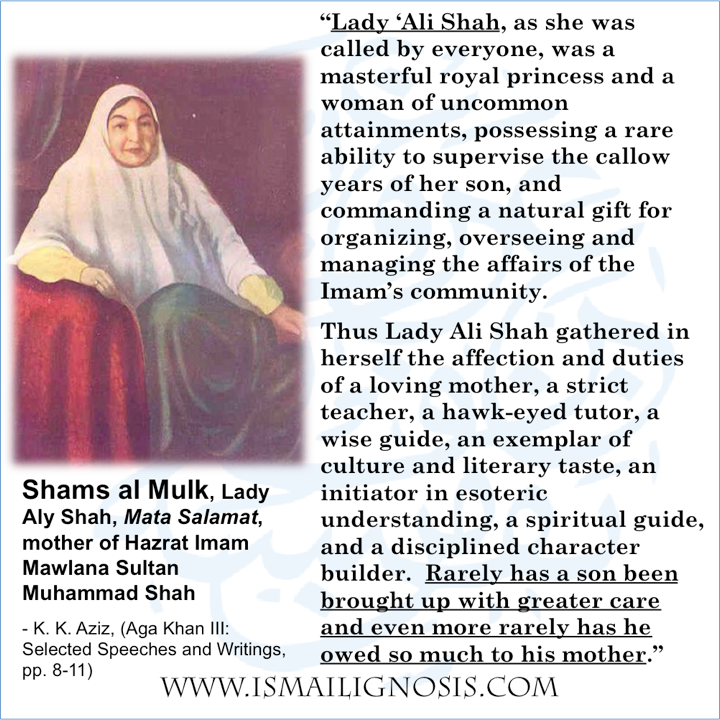
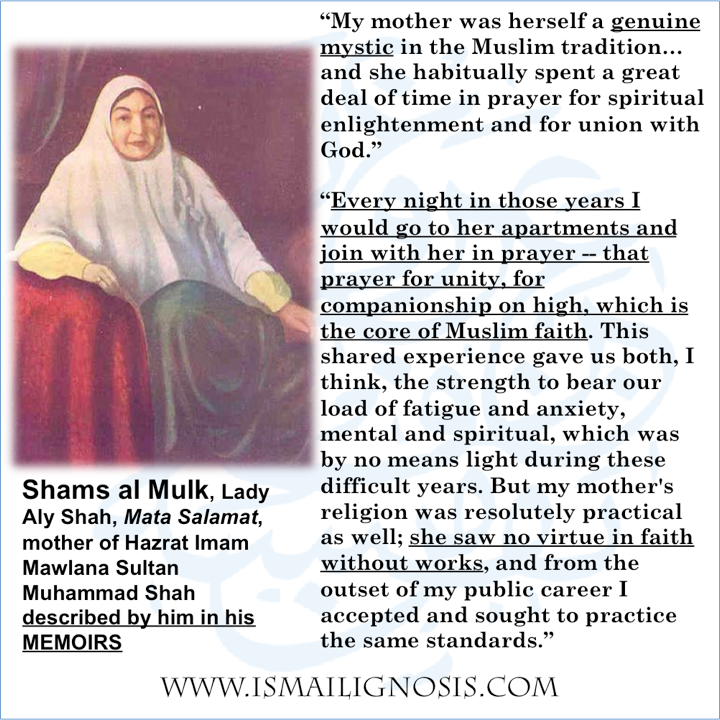

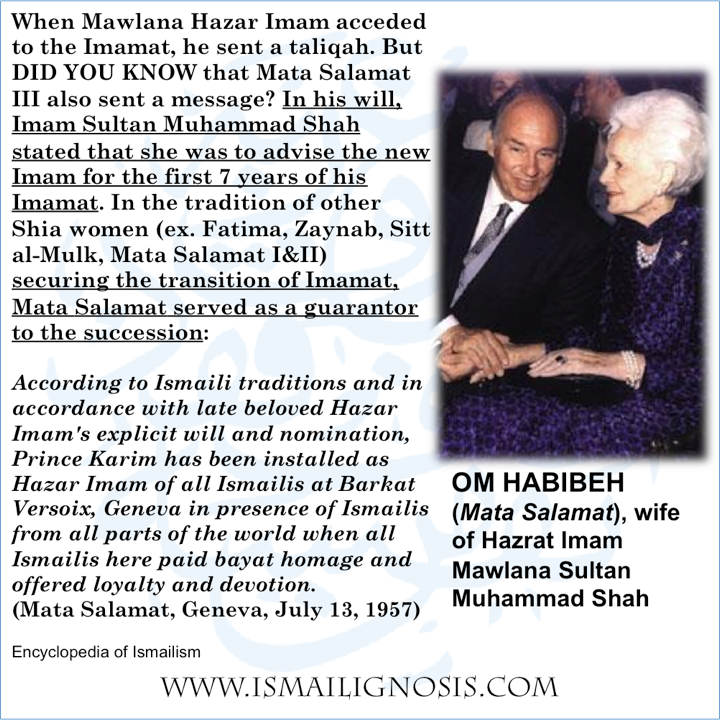

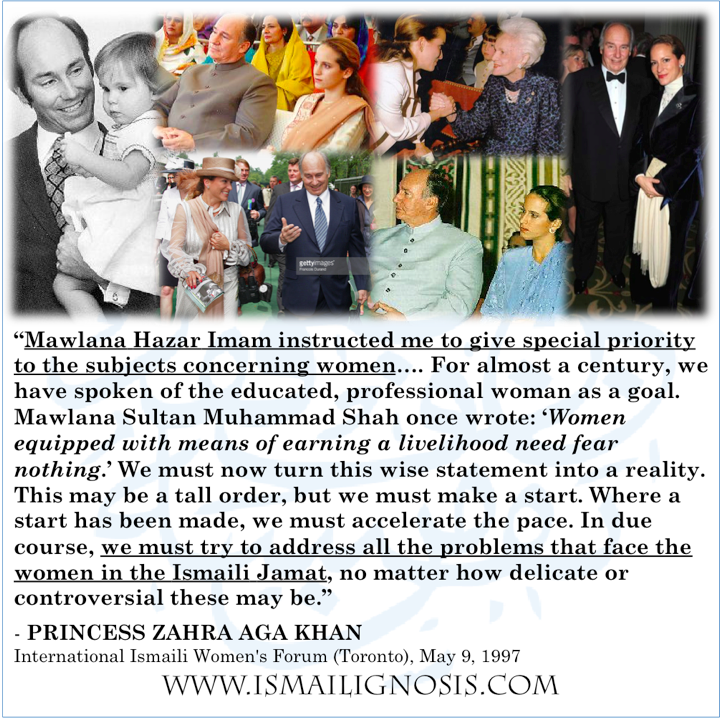
Ya Ali Madad!🙏🏻 Barakallah!))
Отправлено из мобильной Почты Mail.Ru
Вторник, 20 октября 2015 г., 9:02 +0300 от Ismaili Gnosis : >Ismaili Gnostic posted: “ISMAILI WOMEN come from a proud and rich heritage of intellectual prowess, spiritual illumination, and strength against adversity. Ismaili Gnosis @ Instagram presents a series on the history of strong Ismaili women starting with Hazrat Khadijah, the wife ” >
Thank you ismaili gnosis for this beautiful uplifting article about womens place in Islam..and how it has remained a constant source of inspiration and importance in ismaili Tariqa of Islam.
Thank you #ismailignosis for sharing this beautiful article with us.
Reblogged this on Zarina's Weblog.
A praiseworthy tribute to Women in Islam. An exquisite article. Thank you vsery much.